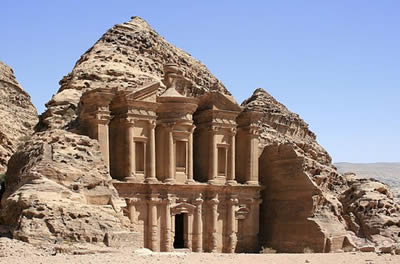Petra refers to the ruins of an ancient city located in southwestern Jordan, about 150 miles (240 km) south of the capital Amman. It is known for its remarkable rock-hewn architecture. Petra was the capital city of the indigenous Nabataean Arabs between 400 B.C. and 106 A.D. It reached its height as a spice trading center under the Nabateans in the first century B.C.
Archaeologists have discovered more than 500 known temples, tombs, structures and monuments at Petra. The city also had a theater, a colonnaded street, and a system of tunnels and dams that channeled rainwater to reservoirs. Parts of the structures were built, while others were carved directly into the rockface. Petra’s rose-colored sandstone has garnered it the nickname the “Rose-Red City.”
Recent research shows that many of Petra’s important tombs and buildings are aligned with the position of the rising or setting sun on solar marker days. For example, some of the structures are oriented so that the sun illuminates their inner chambers on solstices or equinoxes. Others are aligned with points on the horizon where sunrise or sunset intersects prominent landmarks. The area may have been home to 50,000 people at its height. Petra was eventually conquered by the Roman Empire, and later influenced by Byzantine culture. The city’s unique architecture reflects these various cultural influences.
The area may have been home to 50,000 people at its height. Petra was eventually conquered by the Roman Empire, and later influenced by Byzantine culture. The city’s unique architecture reflects these various cultural influences.
Large earthquakes severely damaged the city in the fourth and fifth centuries, and Petra was ultimately abandoned by the 7th Century A.D. Changing trade routes and floods may also have contributed to the city’s demise.
The Petra area is also known for Mount Hor (or Jebel Haroun), which is the reputed burial site of Aaron, the brother of Moses. The ancient city remained unknown to outsiders until 1812, when Swiss geographer Johann Burckhardt disguised himself as a Bedouin pilgrim to Mount Hor, and convinced his guide to direct him to the site. The vast majority of the city has not been excavated, and remains buried underground. UNESCO designated Petra a World Heritage Site in 1985. In 2007, it was named one of the new seven wonders of the world.
Petra, Jordan
- Written by Kate Dougherty
- Category: Places